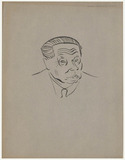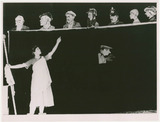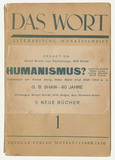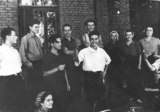Moscow
Mein Zimmer im Hotel „Lux“, dem Gemeinschaftshaus der Komintern, zeigt noch Spuren des wüsten Durcheinanders nach der Haussuchung und Verhaftung meines Mannes vor nun drei Tagen. Auf dem Boden liegen Bücher und Papierfetzen. Jetzt kommen die drei Maifeiertage, die Gefängnisschalter werden geschlossen sein, und ich kann nichts für ihn tun!
[My room in the “Lux” hotel, the Comintern’s community house, still shows signs of the desolate mess left by the house search and my husband’s arrest three days ago. Books and scraps of paper are lying about on the floor. Now we have the three-day May holiday, the prison reception will be closed, and there’s nothing I can do for him! (ed. trans.)]
Margarete Buber-Neumann on the imprisonment of her husband 1937 in Als Gefangene bei Stalin und Hitler, 1949
Moscow was a major destination for exiles, particularly for the German Communists who were forced to leave from 1933 onwards. However of the 4,600 or so German emigrants who arrived in the Soviet Union, only a small number were able to live in the capital. The Soviet Union had been subject to a housing shortage since the 1930s, meaning that exiles, particularly, found it difficult to establish a footing in Moscow. Those who called the capital of the Soviet Union home were generally German Communist Party heads and members of the Comintern. Many resided in the Lux hotel, where leading international Communist functionaries had been accommodated since 1921. Emigrants gathered in two clubs, primarily the Foreign Workers’ Club, as well as the Central Library for Foreign Literature. For émigré journalists and artists, Moscow offered a wealth of work opportunities and the chance to make contacts. German-language writers were able to publish their books through the Co-operative Publishing Society of Foreign Workers in the USSR. The Deutsche Zentralzeitung (German Central Newspaper), which had been in operation since 1926, reached a circulation of 40,000 during the 1930s. The numerous international artists’ groups and political committees made it easier for creative professionals to get in contact with one another. While numerous émigré journalists and writers had entered the Soviet Union, visual artists played a comparatively minor role. Journalists found outlets for their work in the Moscow-based German-speaking exile journals, such as the Das Wort, established in 1936, and Internationale Literatur published under the guidance of Johannes R. Becher. Das Wort soon gained widespread prominence, with its editors scattered across Europe – Willi Bredel in Moscow, Bertolt Brecht in Svendborg and Lion Feuchtwanger in Sanary-sur-Mer – as well as its numerous contributors, including Anna Seghers, the sole female. Circulation rose from 7,000 in 1936 to around 12,000 by 1939.
From 1936 onwards the Stalinist regime conducted mass persecution of its own citizens, as well as many of the German emigrants, under the pretext that they were rooting out spies and saboteurs. Emigrant residential accommodation was particularly dangerous: a large number of the German inhabitants were arrested and murdered by the Soviet secret service, the NKVD.
Further reading:
Jarmatz, Klaus, Simone Barck und Peter Diezel: Exil in der UdSSR. Leipzig: Reclam 1979
Müller, Reinhard: Menschenfalle Moskau: Exil und stalinistische Verfolgung, 1. Aufl.. Hamburg: Hamburger Edition 2001
Tischler, Carola: Flucht in die Verfolgung: deutsche Emigranten im sowjetischen Exil; 1933 bis 1945. Münster: Lit 1996
Weber, Hermann: „Hotel Lux. Die deutsche kommunistische Emigration in Moskau“. Sankt Augustin: Konrad-Adenauer-Stiftung 2006







